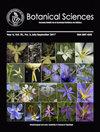Exogenous trehalose protects photosystem II in heat-stressed wheat
IF 0.7
4区 生物学
Q3 PLANT SCIENCES
引用次数: 0
Abstract
Background: Photosystem II (PSII) is susceptible to heat stress. Plants naturally accumulate trehalose to improve stress tolerance. However, the mechanism by which trehalose affects PSII during heat stress is still unknown. Questions: How does trehalose affect PSII during heat stress? Studied species: Triticum aestivum L. Study site and dates: Shanghai, China. 2019-2021. Methods: Trehalose -pretreated wheat seedlings suffered from heat stress and their photosynthetic parameters were measured. Results: Heat stress caused a reduction in the photochemical efficiency of PSII, the electron transfer rate (ETR(II)), the quantum yield of regulated energy dissipationY(NPQ) and the coefficient of photochemical quenching (qP), but increased the quantum yield of non-regulated energy dissipation of PSII (Y[NO]). The shape of the fast chlorophyll fluorescence induction kinetics (OJIP) curve in the heat-stressed wheat was altered and the primary photochemistry maximum yield of PSII (Fv/Fo) and the PSII performance indicator PIabs were reduced. Accordingly, the activities of PSII and electron transport chain, the amount of ordered α-helix structures and the content of D1 protein also decreased. However, in trehalose-pretreated wheat, D1 protein and protein secondary structures of PSII were both protected, the electron transport activities of PSII and the whole chain were improved and greater fluorescence parameters values were maintained. Lower Y(NO) and more stable OJIP were obtained. Conclusions: Exogenous trehalose acted a vital role in the protection of the function of PSII, resulting in higherphotosynthetic capacity under heat stress.外源海藻糖对热胁迫小麦光系统II的保护作用
背景:光系统II(PSII)易受热应激的影响。植物自然积累海藻糖以提高抗逆性。然而,海藻糖在热应激过程中影响PSII的机制仍然未知。问题:海藻糖在热应激过程中如何影响PSII?研究物种:小麦。研究地点和日期:中国上海。方法:对海藻糖预处理的小麦幼苗进行热胁迫处理,测定其光合参数。结果:热应力降低了PSII的光化学效率、电子转移速率(ETR(II))、调节能量耗散量子产率Y(NPQ)和光化学猝灭系数(qP),但增加了PSII非调节能量耗散的量子产率(Y[NO])。热胁迫小麦中快速叶绿素荧光诱导动力学(OJIP)曲线的形状发生了改变,PSII的初级光化学最大产量(Fv/Fo)和PSII性能指标PIabs降低。相应地,PSII和电子传输链的活性、有序α-螺旋结构的数量和D1蛋白的含量也降低。然而,在海藻糖预处理的小麦中,PSII的D1蛋白和蛋白二级结构都得到了保护,PSII和整个链的电子传输活性得到了提高,并保持了更大的荧光参数值。获得了更低的Y(NO)和更稳定的OJIP。结论:外源海藻糖在保护PSII的功能中起着重要作用,使其在热应激下具有较高的光合成能力。
本文章由计算机程序翻译,如有差异,请以英文原文为准。
求助全文
约1分钟内获得全文
求助全文
来源期刊

Botanical Sciences
Agricultural and Biological Sciences-Plant Science
CiteScore
1.90
自引率
21.40%
发文量
71
审稿时长
16 weeks
期刊介绍:
Botanical Sciences welcomes contributions that present original, previously unpublished results in Botany, including disciplines such as ecology and evolution, structure and function, systematics and taxonomy, in addition to other areas related to the study of plants. Research reviews are also accepted if they summarize recent advances in a subject, discipline, area, or developmental trend of botany; these should include an analytical, critical, and interpretative approach to a specific topic. Acceptance for reviews will be evaluated first by the Review Editor. Opinion Notes and Book Reviews are also published as long as a relevant contribution in the study of Botany is explained and supported.
 求助内容:
求助内容: 应助结果提醒方式:
应助结果提醒方式:


